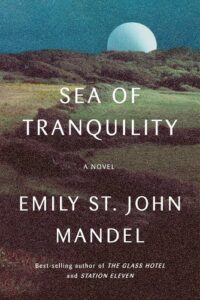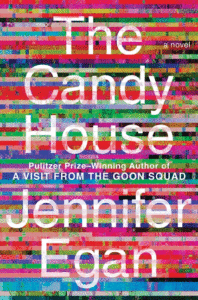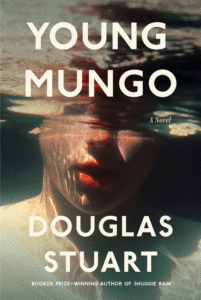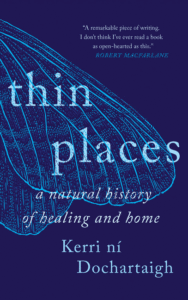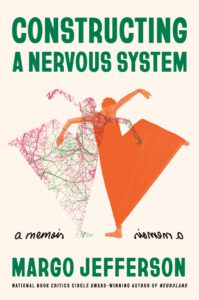
What Should You Read Next? Here Are the Best Reviewed Books of the Month
Featuring new titles by Jennifer Egan, Emily St. John Mandel, Douglas Stuart, Margo Jefferson, and more
Jennifer Egan’s The Candy House, Emily St. John Mandel’s Sea of Tranquility, Douglas Stuart’s Young Mungo, and Margo Jefferson’s Constructing a Nervous System all feature among April’s best reviewed titles.
Brought to you by Book Marks, Lit Hub’s “Rotten Tomatoes for books.”
*
1. Sea of Tranquility by Emily St. John Mandel
(Knopf)
23 Rave • 7 Positive • 3 Mixed • 1 Pan
Read an interview with Emily St. John Mandel here
“In Sea of Tranquility, Mandel offers one of her finest novels and one of her most satisfying forays into the arena of speculative fiction yet, but it is her ability to convincingly inhabit the ordinary, and her ability to project a sustaining acknowledgment of beauty, that sets the novel apart. As in Ishiguro, this is not born of some cheap, made-for-television, faux-emotional gimmick or mechanism, but of empathy and hard-won understanding, beautifully built into language … It is that aspect of Sea of Tranquility, Mandel’s finely rendered, characteristically understated descriptions of the old-growth forests her characters walk through, the domed moon colonies some of them call home, the robot-tended fields they gaze over or the whooshing airship liftoff sound they hear even in their dreams, that will, for this reader at least, linger longest.”
–Laird Hunt (The New York Times Book Review)
2. The Candy House by Jennifer Egan
(Scribner)
22 Rave • 9 Positive • 6 Mixed • 3 Pan
Read an interview with Jennifer Egan here
“… a dizzying and dazzling work that should end up on many Best of the Year lists … The Candy House requires exquisite attentiveness and extensive effort from its readers. But the work and the investment pay off richly, as each strain and thread and character reverberates in a kind of amplifying echo-wave with all the others, and the overarching tapestry emerges as ever more intricate and brilliantly conceived. Enacting the book’s dominant metaphor, Egan is presenting a version of Collective Consciousness: the blending and extension of selfhood across shared experience and identity. One of the book’s most fascinating implications, less patent but pervasive, is how this alternative model of perception does and doesn’t undermine traditional notions of literary consciousness … As we follow the pebbles and crumbs Egan so cannily lays out, readers may feel at times as disoriented or wonderstruck as children making their way through a dark forest, at others electrifyingly clear-sighted, ecstatically certain of the novel’s wisdom, capacious philosophical range, truth and beauty. Charged with ‘a potency of ideas simmering,’ The Candy House is a marvel of a novel that testifies to the surpassing power of fiction to ‘roam with absolute freedom through the human collective.”
–Priscilla Gilman (The Boston Globe)
3.Young Mungo by Douglas Stuart
(Grove Press)
20 Rave • 4 Positive • 2 Mixed • 1 Pan
Listen to an interview with Douglas Stuart here
“Stuart writes like an angel … masterful … if Stuart has not departed much from the scaffolding of his debut novel, he has managed to produce a story with a very different shape and pace … The raw poetry of Stuart’s prose is perfect to catch the open spirit of this handsome boy, with his strange facial tics … The way Stuart carves out this oasis amid a rising tide of homophobia infuses these scenes with almost unbearable poignancy … Stuart quickly proves himself an extraordinarily effective thriller writer. He’s capable of pulling the strings of suspense excruciatingly tight while still sensitively exploring the confused mind of this gentle adolescent trying to make sense of his sexuality … The result is a novel that moves toward two crises simultaneously: whatever happened with James in Glasgow and whatever might happen to Mungo in the Scottish wilds. The one is a foregone calamity we can only intuit; the other an approaching horror we can only dread. But even as Stuart draws these timelines together like a pair of scissors, he creates a little space for Mungo’s future, a little mercy for this buoyant young man.”
–Ron Charles (The Washington Post)
**
1. Thin Places by Kerri ní Dochartaigh
(Milkweed)
9 Rave • 7 Positive • 2 Mixed
“Can the Irish border be described as a ‘thin place’? Never have I read such an eloquent description for the omnipresent border in our psyche … Readers will draw their own meaning from Ní Dochartaigh’s words, and she allows space for them to ponder … This debut is not a memoir in the traditional sense; nor is it simply a polemic about the sectarian violence that tore through the author’s childhood in Derry; instead, it combines both of these elements under the insistent gaze of the poet-writer who is always keen to draw our attention to nature … Readers may be surprised at the depths that Thin Places explores. Do not mistake its appreciation of the natural world for anything twee or solely comforting … This is not for the faint-hearted … Ní Dochartaigh’s writing is generous and she leaves little for the reader to surmise in those dark days she describes in startling detail … The darkness in her subject matter lends itself to the light, however. The natural world at large is a balm for her … It might sound incongruous to write about the beauty of the whooper swan and the enduring effect of Troubles in the same paragraph, but Ní Dochartaigh’s manages it … This is a book full of hope found in dark places and it confronts some of the realities of the Irish border and the enduring effect it has on our lives.”
–Mia Colleran (The Irish Independent)
2. Constructing a Nervous System by Margo Jefferson
(Pantheon)
10 Rave • 1 Positive
“Rather than using her life’s narrative to structure the book, she organizes her becoming through her models. Who, she asks herself, were those people she secreted away? In whose eyes did she see herself reflected? The collection is unorthodox … Memoir, the highest form of autofiction, is an unmannerly genre. Its appeal lies in its indecency. Jefferson’s indecency lies in her honesty about the contortions into which black intellectuals have long been forced … Jefferson doesn’t shy away from her attraction to certain artists who might otherwise have earned her disavowal. She is at her most dexterous when discussing two otherwise unrelated giants: Ike Turner and Willa Cather … The book is a marvel as a work of criticism and would serve well as a manual for writing, in the sense of teaching the practice as a means of thinking. As in Negroland, Jefferson circles back on herself, questioning, clarifying, and complicating her own intentions. She works through what cannot quite be expressed … The brilliance of the culture we have shaped is not dimmed by the pressure of Jefferson’s interrogation. What’s left is something awe-inspiring, but more fractious, more prone to false starts and massive leaps. Its power demands such criticism, such insistent questioning.”
–Blaire McClendon (Bookforum)
3. Blood and Ruins by Richard Overy
(Viking)
9 Rave • 1 Positive
Read an excerpt from Blood and Ruins here
“…let’s praise Overy’s stupendous achievement. Anybody interested in the why and how of boundless violence in the 20th century should make space for Blood and Ruins on his or her shelf. It will help you to grasp and revisit the carnage of 1931-45 as the largest event in human history. No continent, no ocean was spared, and Overy deftly weaves all the subplots into one planetary tapestry of merciless ideology and industrialized extermination. This book is not Eurocentric, but truly geocentric … Blood and Ruins dissects the sinews of war with the sharpest of scalpels. With myriad facts, it is not for the night stand, where it must compete with Netflix. But it is history at its best, down to the finest points culled from a dozen archives around the world … While watching the talking heads on CNN, keep this masterly work by your side.”
–Josef Joffe (The New York Times Book Review)
Book Marks
Visit Book Marks, Lit Hub's home for book reviews, at https://bookmarks.reviews/ or on social media at @bookmarksreads.










